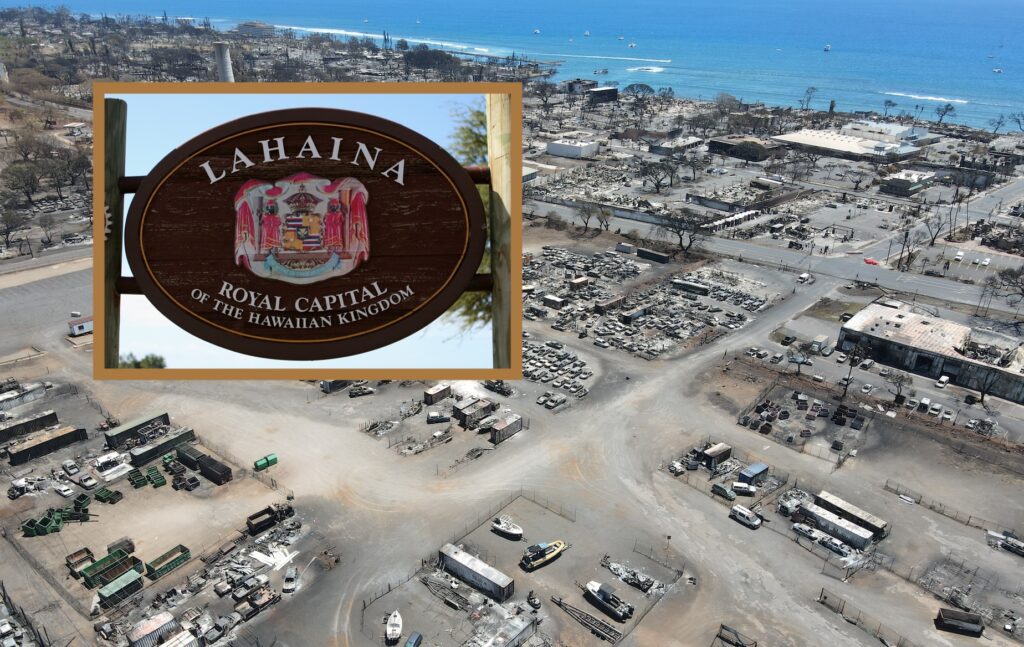US funds keep flowing to Ukraine as little Maui struggles to rebuild
It’s a David and Goliath story for the ages: a tiny island struggles to rebuild after devastating fires one year ago, while a European war rages after more than two years, consuming billions of…

It’s a David and Goliath story for the ages: a tiny island struggles to rebuild after devastating fires one year ago, while a European war rages after more than two years, consuming billions of dollars in U.S. funds.
Maui didn’t face a war, but residents of the Hawaiian island know all about desolation.
In the year since wildfires killed 102 people and destroyed a school, businesses and 1,400 homes, fewer than 100 potential new homes are even in the permitting process to rebuild.
Businesses remain closed and downtown Lahaina, a once-thriving tourist city on the island’s west side, is in shambles. It’s so desolate it resembles a war zone.
The U.S. government has pledged nearly $3 billion toward the rebuilding effort, but that pales in comparison to the $175 billion given to Ukraine since the war began with Russia in February of 2022. Maui’s funds represent less than 2% of what Ukraine’s received.
The discrepancy is so glaring that popular podcast host Joe Rogan is talking about it.
“Imagine being a person in Maui that lost your home,” Rogan said on “The Joe Rogan Experience” last month. “They give you $700, and then you still can’t rebuild. It’s a year later, nothing’s been built.”
Rogan was addressing $700 emergency payments made to individuals and households affected by the wildfires to cover critical needs.
Progress is slow, even though the government has used numerous agencies and programs to help with everything from school reconstruction to temporary housing and small business loans. Even the $3 billion may only cover about half of what’s needed to rebuild the island.
“And in the blink of an eye, they give $100 million to [Ukraine’s President Volodymyr] Zelensky,” guest Jimmy Dore told Rogan.
The money for Ukraine has flowed so freely that the Pentagon discovered an “accounting error” in June which meant that an additional $6.2 billion could go to Ukraine by mistake. Since military equipment had apparently been overvalued, the government decided it could send an additional $6.2 billion within its approved allotment.
Another $2 billion in accounting errors was found in late July, prompting Rogan to do some research.
“We looked up how much would it cost to rebuild every house that got destroyed in the fire: $5 billion,” Rogan said. “So (the federal government) could have done that. Why wouldn’t they do that? I don’t understand. Those people are devastated.”
Maui’s ruin
Devastation doesn’t even begin to describe what parts of Maui experienced.
More than 9,000 people were displaced, with more than half of those reporting that they moved three or more times in the last year. Debris is still being cleaned up, and utilities must still be restored to parts of the island, which is slowing down home reconstruction.
Children have returned to school, as the government hastily reconstructed a temporary campus for the decimated King Kamehameha III Elementary School in just over three months. Debate about where to locate the permanent campus continues, as some fear damage from future wildfires.
Costs are a primary hindrance to rebuilding: construction is up and materials have risen from inflation. But values covered by homeowners’ insurance don’t always reflect this, especially if the home is older.
Then there’s the economy. School and residential construction is being prioritized over rebuilding businesses, but that puts a damper on the island, which relies heavily on tourism.
Lahaina’s Front Street, which was ranked as one of America’s “Top Ten Greatest Streets” by the American Planning Association, is completely unrecognizable today. One state senator said it could take “10-20 years” at the current pace for downtown Lahaina to return to what it once was.
Perhaps most grueling is the mental stress.
“I don’t think anyone’s talked about how many suicides and how many things have happened post-fire, how much depression, how much PTSD,” says a quote from a June report by the Hawaii State Rural Health Association. “Everyone I know that was involved in it or escaping it, that is a friend of mine, is dealing with post-traumatic PTSD. Every time the wind blows harder, every time that ambulance goes by.“
“I have not slept a full eight hours in seven months,” read another quote, while others talked about struggling to find shelter or not knowing how to work through the federal bureaucracy to get help.
Hawaiian politicians are asking Congress to approve more funds for Maui. Those dollars are being debated, but the money for Ukraine keeps flowing.
Congress authorized $61.3 billion for Ukraine in April, another $2.3 billion was announced in July and $125 million in new military aid was reported Thursday. There’s seemingly no end in sight, although election outcome in November could have an effect. (The U.S. was spending about $5.4 billion per month on the war at one point, and the current funding is forecast to run out sometime around January, two months after the U.S. Presidential election).
“The people of Lahaina still need help,” Hawaii’s congressional delegation said in a June statement. “Their lives are nowhere near back to normal, and it will take sustained support from the federal government to get them fully back on their feet. … Congress needs to pass this funding quickly and get people the help they urgently need.”
Rogan again pointed to a lack of attention for Maui, while much focus remains on Ukraine.
“It’s happening in front of our eyes and no one’s doing anything about it because it’s five hours in a jet across the ocean,” Rogan said.



